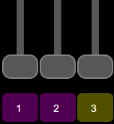Playbacks
The faders can operate the levels of the playbacks. Playbacks can contain one lighting look, or they can contain a sequence, which is made up of multiple lighting looks. Playbacks are mixed with Highest-Takes-Precedence (HTP) for both intensity and color. HTP means that the highest level of all sources will be used.
If two playbacks are up and contain the same channels with differing colors, the resulting color will be the combination of the two. For example, if one playback has a channel set to green and another playback has the same fixture set to red, when they are mixed the fixture will turn yellow.
When playbacks also carry parameter values for automated fixtures, parameters may be run up or down on a playback fader until another playback or cue takes control of them.
There are 10 pages of playbacks. If the page is changed, playbacks that are currently up will not change immediately to the new page and must be brought first to zero. Playback faders may also carry sequences of up to 99 timed steps.
Page 10 is a special case. It may be used in the same way as other pages, or it can be used as a temporary store for remote recordings. Each time a remote recording is requested, the entire output state, including any running media,is stored as a snapshot to a playback on page ten and the snapshot counter is incremented. If more than 20 (40) recordings are made, the counter rolls round to playback #1.
Simple static playbacks are shown in mauve on the bump button, sequences are shown in yellow on the button.

The playbacks are all controlled by the playbacks master fader. When the playback master is at zero, playbacks containing position data will only play back position data.
The Playback Toy display can be used to only run certain parameters of a playback. See Playback Toy for more information.